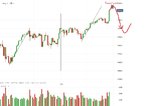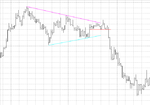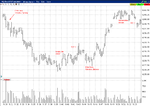dbphoenix
Guest Author
- Messages
- 6,954
- Likes
- 1,266
I've been asked why it matters whether or not one has spent (wasted?) time watching price move, particularly if he's not daytrading. After all, daily (weekly, monthly) charts don't move; they're just there, take them or leave them.
I suppose it has to do with depth of knowledge. I don't post anywhere else. It's too much bother and has little to no result, largely because the signal to noise ratio is so extreme. But I do read a lot of posts, and it's clear to me that very few people -- very few people -- have any idea what's going on in front of them, which is likely why their charts are so filled with lines and colors and shapes of one sort or another in so many windows it's next to impossible to make sense of whatever information they're seeking to provide themselves. If their charts had sound, they'd be a rock concert with the volume set at 11.
Which brings me back to depth of knowledge. Not breadth. Depth. Think of someone who is viewing photographs of the ocean. This someone has been to the seashore, collected shells, waded in the ocean, sailed a boat, paddled a canoe, traveled on a ferry or a ship. He's going to have a very different reaction to these photographs than someone who's never even been to the beach, much less set foot in the water. The movement of the water, of the currents, of the wind and its effects on the water play no part in his perceptions because he's never experienced them. His perceptions don't have the depth of the person who's intimately familiar with the water.
It's not too much of a stretch to apply this to chart-reading. Wyckoff began as a tape reader. Therefore, everything he says about price movement on charts is informed by that experience, whether of support, resistance, turning points, strength, weakness, trend, or any other aspect of movement. He sees price even on a daily chart as something that is fluid, in constant motion, something that is the result of a never-ending back-and-forth among buyers and sellers. Does the depth of this knowledge affect the judgments that are made regarding what is seen on the chart? Given the confusion and misunderstandings I encounter in countless posts that result from the absence of this depth, I have to say yes.
And so I continue to suggest that those who want to be successful traders as opposed to those who are just looking for something to pass the time spend at least a little of that time watching price move. If the experience has no effect on how one views his daily chart, then so be it. What does one have to lose?
I suppose it has to do with depth of knowledge. I don't post anywhere else. It's too much bother and has little to no result, largely because the signal to noise ratio is so extreme. But I do read a lot of posts, and it's clear to me that very few people -- very few people -- have any idea what's going on in front of them, which is likely why their charts are so filled with lines and colors and shapes of one sort or another in so many windows it's next to impossible to make sense of whatever information they're seeking to provide themselves. If their charts had sound, they'd be a rock concert with the volume set at 11.
Which brings me back to depth of knowledge. Not breadth. Depth. Think of someone who is viewing photographs of the ocean. This someone has been to the seashore, collected shells, waded in the ocean, sailed a boat, paddled a canoe, traveled on a ferry or a ship. He's going to have a very different reaction to these photographs than someone who's never even been to the beach, much less set foot in the water. The movement of the water, of the currents, of the wind and its effects on the water play no part in his perceptions because he's never experienced them. His perceptions don't have the depth of the person who's intimately familiar with the water.
It's not too much of a stretch to apply this to chart-reading. Wyckoff began as a tape reader. Therefore, everything he says about price movement on charts is informed by that experience, whether of support, resistance, turning points, strength, weakness, trend, or any other aspect of movement. He sees price even on a daily chart as something that is fluid, in constant motion, something that is the result of a never-ending back-and-forth among buyers and sellers. Does the depth of this knowledge affect the judgments that are made regarding what is seen on the chart? Given the confusion and misunderstandings I encounter in countless posts that result from the absence of this depth, I have to say yes.
And so I continue to suggest that those who want to be successful traders as opposed to those who are just looking for something to pass the time spend at least a little of that time watching price move. If the experience has no effect on how one views his daily chart, then so be it. What does one have to lose?







